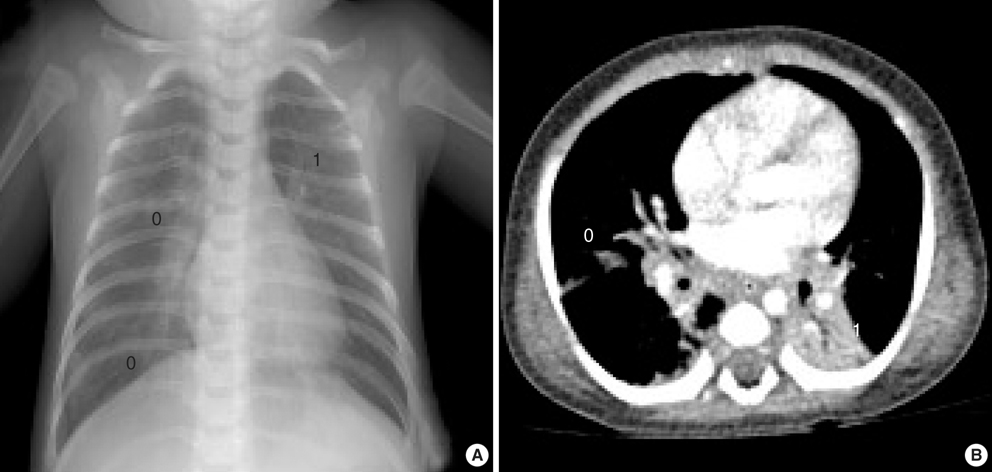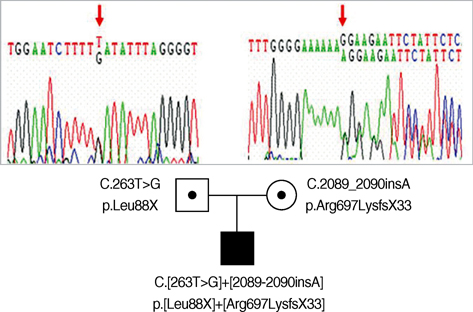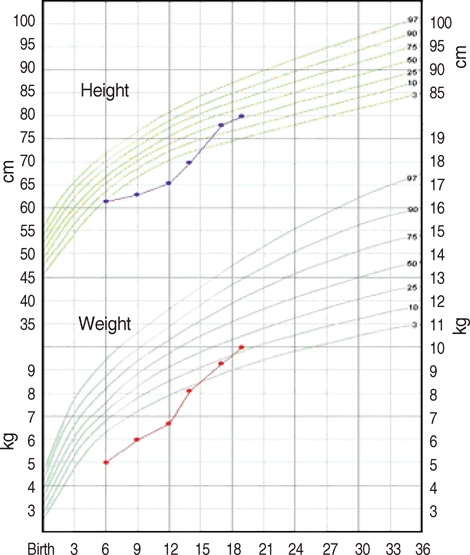J Korean Med Sci.
2008 Oct;23(5):912-915. 10.3346/jkms.2008.23.5.912.
Identification of a Novel Mutation of CFTR Gene in a Korean Patient with Cystic Fibrosis
- Affiliations
-
- 1Department of Pediatrics, Asan Medical Center, University of Ulsan College of Medicine, Seoul, Korea. hwyoo@amc.seoul.kr
- 2Medical Genetics Clinic and Laboratory, Asan Medical Center, University of Ulsan College of Medicine, Seoul, Korea.
- KMID: 1783084
- DOI: http://doi.org/10.3346/jkms.2008.23.5.912
Abstract
- Cystic fibrosis (CF) is the most common lethal autosomal recessive disease in Caucasians, but rare in Asians. The mutations of cystic fibrosis transmembrane conductance regulator (CFTR) gene are responsible for CF. To date, less than 5 cases of CF have been reported and a few of them diagnosed based on the genotype of the CFTR gene in Korea. We encountered a 4-month-old Korean infant with CF and the diagnosis was confirmed by CFTR gene mutation analysis. The patient underwent surgical operation, due to meconium ileus at birth. He suffered by recurrent respiratory infections, failure to thrive, fatty liver with hepatomegaly, and cholestasis. The mutations of the CFTR gene were identified in the patient and his parents. The patient was a compound heterozygote with a nonsense mutation of c.263T>G, resulting in an amino acid change of p.Leu88X in exon 3. It was previously described in a Korean patient with CF. The other is a novel mutation; c.2089-2090insA mutation (p.Arg697LysfsX33) in exon 13. The mutation c.263T>G was inherited from his father, and the c.2089-2090insA mutation from his mother. Respiratory infection was recovered by supportive care, and cholestasis was improved slowly with sufficient feeding and supplementation of pancreatic exocrine enzymes. He is 19- month old now and shows catch-up growth. We report a novel CFTR mutation in a Korean infant with CF.
Keyword
MeSH Terms
Figure
Cited by 1 articles
-
Heterogeneous Spectrum of
CFTR Gene Mutations in Korean Patients with Cystic Fibrosis
Haiyoung Jung, Chang-Seok Ki, Won-Jung Koh, Kang-Mo Ahn, Sang-Il Lee, Jeong-Ho Kim, Jae Sung Ko, Jeong Kee Seo, Seung-Ick Cha, Eun-Sil Lee, Jong-Won Kim
Korean J Lab Med. 2011;31(3):219-224. doi: 10.3343/kjlm.2011.31.3.219.
Reference
-
1. Tizzano EF, Buchwald M. Cystic fibrosis: beyond the gene to therapy. J Pediatr. 1992. 120:337–349.
Article2. Farrell PM. Improving the health of patients with cystic fibrosis through newborn screening. Wisconsin Cystic Fibrosis Neonatal Screening Study Group. Adv Pediatr. 2000. 47:79–115.3. Ahn KM, Park HY, Lee JH, Lee MG, Kim JH, Kang IJ, Lee SI. Cystic fibrosis in Korean children: a case report identified by a quantitative pilocarpine iontophoresis sweat test and genetic analysis. J Korean Med Sci. 2005. 20:153–157.
Article4. Yamashiro Y, Shimizu T, Oguchi S, Shioya T, Nagata S, Ohtsuka Y. The estimated incidence of cystic fibrosis in Japan. J Pediatr Gastroenterol Nutr. 1997. 24:544–547.
Article5. Koh WJ, Ki CS, Kim JW, Kim JH, Lim SY. Report of a Korean patient with cystic fibrosis, carrying Q98R and Q220X mutations in the CFTR gene. J Korean Med Sci. 2006. 21:563–566.
Article6. Rosenstein BJ, Cutting GR. The diagnosis of cystic fibrosis: a consensus statement. Cystic Fibrosis Foundation Consensus Panel. J Pediatr. 1998. 132:589–595.7. Zielenski J, Tsui LC. Cystic fibrosis: genotypic and phenotypic variations. Annu Rev Genet. 1995. 29:777–807.
Article8. Macek M Jr, Hamosh A, Kiesewetter S, McIntosh I, Rosenstein BJ, Cutting GR. Identification of a novel nonsense mutation (L88X) in exon 3 of the cystic fibrosis transmembrane conductance regulator gene in a native Korean cystic fibrosis chromosome. Hum Mutat. 1992. 1:501–502.
Article9. Rowe SM, Miller S, Sorscher EJ. Cystic fibrosis. N Engl J Med. 2005. 352:1992–2001.
Article10. Wilmott RW. Making the diagnosis of cystic fibrosis. J Pediatr. 1998. 132:563–565.
Article11. Lee JH, Choi JH, Namkung W, Hanrahan JW, Chang J, Song SY, Park SW, Kim DS, Yoon JH, Suh Y, Jang IJ, Nam JH, Kim SJ, Cho MO, Lee JE, Kim KH, Lee MG. A haplotype-based molecular analysis of CFTR mutations associated with respiratory and pancreatic diseases. Hum Mol Genet. 2003. 12:2321–2332.12. Casals T, Ramos MD, Gim J, Larriba S, Nunes V, Estivill X. High heterogeneity for cystic fibrosis in Spanish families: 75 mutations account for 90% of chromosomes. Hum Genet. 1997. 101:365–370.
Article13. Wu CL, Shu SG, Zielenski J, Chiang CD, Tsui LC. Novel cystic fibrosis mutation (2215insG) in two adolescent Taiwanese siblings. J Formos Med Assoc. 2000. 99:564–567.14. Correlation between genotype and phenotype in patients with cystic fibrosis. The Cystic Fibrosis Genotype-Phenotype Consortium. N Engl J Med. 1993. 329:1308–1313.15. Kristidis P, Bozon D, Corey M, Markiewicz D, Rommens J, Tsui LC, Durie P. Genetic determination of exocrine pancreatic function in cystic fibrosis. Am J Hum Genet. 1992. 50:1178–1184.16. Zielenski J. Genotype and phenotype in cystic fibrosis. Respiration. 2000. 67:117–133.
Article17. De Braekeleer M, Allard C, Leblanc JP, Aubin G, Simard F. Is meconium ileus genetically determined or associated with a more severe evolution of cystic fibrosis? J Med Genet. 1998. 35:262–263.
Article
- Full Text Links
- Actions
-
Cited
- CITED
-
- Close
- Share
- Similar articles
-
- Cystic fibrosis in a female adolescent carrying c.263T>G (p.Leu88X) and c.2977G>T (p.Asp993Tyr) mutation
- F508 amino acid deletion mutation of CFTR gene in Korean lung cancer patients
- A case Report of a Classic Cystic fibrosis Pediatric Patient in Korea Carrying Very Rare CFTR Gene Mutations (D993Y and Q220X)
- Expression of Cystic Fibrosis Transmembrane Regulator in Nasal Polyps
- The L441P Mutation of Cystic Fibrosis Transmembrane conductance Regulator and its Molecular Pathogenic Mechanisms in a Korean Patient with Cystic Fibrosis




